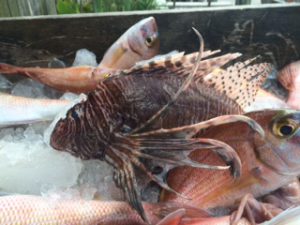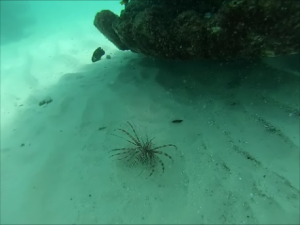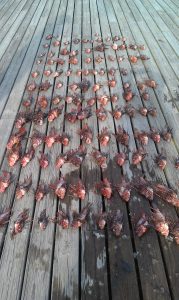Since the first lionfish was spotted off Pensacola in 2010, panhandle organizations have been busy trying to control the spread of this invasive species. The story is well known to many… the lionfish is a voracious predator, consuming at least 70 different species of small reef fish, including vermillion snapper. They reproduce frequently, producing an average of 25,000 eggs/female every four days – and they breed during most of the year. The densities of these fish on our nearshore and offshore reefs are some of the highest in the South Atlantic region, and they prefer artificial reefs to natural bottom. We know they have spread across the northern Gulf to include all five Gulf states and are found in Mexican waters.
We also know that the primary method of removal is still spearfishing. The state of Florida has an open season on them and provides a program to assist local divers with selling their harvest. There are several rodeo tournaments along the Gulf coast and some traditional fishing tournaments have created a category for them. Education programs about the problem continue and some restaurants have offered them when they can get them.
So how are things going?
Are we on top of controlling the lionfish?
Anecdotal reports suggest we have made some impact. Local divers in the Pensacola area report that the shallower public reefs frequented by local divers and dive charters have indicated they are getting harder to find. There have been some tour trips, taking out of town residents diving for lionfish, where they have had to really search to find them. This is certainly encouraging and a numerical assessment of this is needed. However, there are also reports of charter fishing boats catching them on hook and line in deeper waters. They are not catching many, but they do occasionally grab them. When they do, it is usually on live bait and in deep water, 200 feet or so. Local divers seem to agree with this. They too find more lionfish, and some large ones, at depth – too deep to take a typical dive charter trip to remove.
Recent research has shown that lionfish are able, at least in the northern Gulf of Mexico, to swim greater distances than once thought to re-colonize reefs that have been cleaned. One study showed that selected artificial reefs, which were completely cleaned of lionfish, had restored lionfish populations, both young and old fish, within a year. This same study suggests that to keep lionfish at relatively low-density (about 5 lionfish/100 m 2) reefs would need to be cleaned every two months.
Several lionfish derbies occur along the Florida panhandle, but not at the frequency that may be needed to control re-colonization of shallower reefs by lionfish from deeper ones.
Can we increase the number of derbies?
Sure… but those who work on these derbies know the time and financial commitment required to put one on. It could happen that the number of local derbies would increase but we may have to think of other means of controlling lionfish.
One idea is to increase the number who harvest commercially. To do so a diver would need to acquire a saltwater products license from the Florida Fish and Wildlife Conservation Commission (FWC). On their website, they provide the application and a list of approved buyers for the diver to contact. http://www.myfwc.com/Lionfish.
One drawback to the commercial idea is the price. Currently divers require a high price for their catch in order to cover cost and show a profit. These high prices equate to high prices at local restaurants, higher than the public may be willing to pay. One unpublished study shows that some locals are willing to pay more for a lionfish dinner if they know it is helping the environment. Many seafood lovers understand the high cost of lobster, but have not placed lionfish in the same category and are not as willing to pay higher prices; this may have to change. Research continues on developing a lionfish trap that has low by-catch rates. If an effective trap is developed, they could be deployed from vessels, which would not require diving, and could bring prices down.
There is evidence that populations of small reef fish have significantly declined since 2010. Whether this was due to the oil spill, the lionfish invasion, or a combination is still not certain. It is known that local reefs that are cleaned of lionfish are repopulated with both large and small lionfish. We have had some success with removing but we still have work to do.
Reference
Dahl, K.A., W.F. Patterson, R.A. Snyder. 2016. Experimental Assessment of Lionfish Removals to Mitigate Reef Community Shifts on Northern Gulf of Mexico Artificial Reefs. Marine Ecology Progress Series. Vol 558. Pp: 207-221.
- Rattlesnakes on Our Barrier Islands; Part 1 Knowing the Snake - December 8, 2025
- Tips for Bear Encounters this Fall - November 10, 2025
- Pensacola Bay Invasive Species Summer Survey 2025 - November 3, 2025



